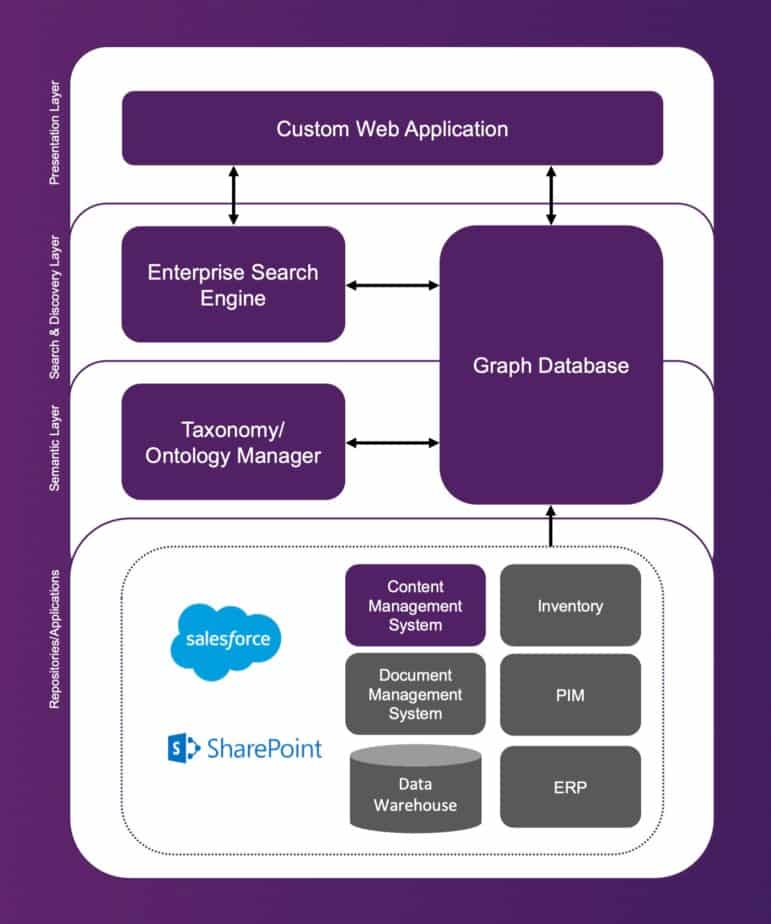Nearly a quarter-century ago, I began my career in Knowledge Management helping organizations to design and implement portals. At the time, portals were one of the first enterprise knowledge management technologies to hit the market, arising as a reaction to digital knowledge sprawl and findability issues in organizations that had embraced digital knowledge and information but were struggling to manage it properly and get it in the hands of the right people.
The first decade of the 2000s saw a massive surge of organizations embracing portals. Companies including Plumtree, BEA, SAP, Vignette, Oracle, Microsoft, and IBM all went to market with their own offerings. I spent that decade honing the People, Process, Content, and Culture elements of implementing portals, with a focus on taxonomies, content governance, content types, and change management, amongst others. Though there were some real successes, for the most part neither the software nor the organizations procuring it were ready to embrace it. In most cases, too much time was spent getting the systems to function properly, with too little effort spent structuring content, enhancing it with metadata, and building in personalized experiences for the appropriate audiences.
By the second decade of the century, portals had largely fallen out of vogue. For many organizations, they became associated with other failed Knowledge Management initiatives, another example of garbage-in, garbage-out types of initiatives that floundered due to poor content quality, governance, findability, and usability. Industry trends moved more toward search solutions to solve findability issues, and Microsoft and other organizations successfully pivoted from portal technologies that indexed content at its source, to more content/document management solutions where content would be loaded directly into the tool (i.e. SharePoint and O365).
Back at the beginning of the year, in my annual KM Trends Blog, I identified the resurgence of portals in their modern form. The activities of the year have further validated that trend, with many of our clients making new multi-year and multi-million dollar investments in Knowledge Portals.
What is a Knowledge Portal?
Unlike the failures of the aughts, Knowledge Portals now couple advanced technologies with the significantly more mature Knowledge Management methodologies around human-centered design, content, taxonomy/ontology, and governance, amongst others. Contrasting the definition of portals from their first iteration, today’s Knowledge Portals are not a single technology solution, but rather an integrated suite, typically comprised of a web front-end, content management solution, enterprise search, and knowledge graph (typically with a taxonomy/ontology management tool as well). The basic components of the Knowledge Portal all play an important role in addressing the shortfalls of past portal technologies:
- Web Front-End – Delivers a highly customized, multichannel or omnichannel experience that helps to avoid vendor lock-in while providing maximum usability and delivering the exact type of experience the organization is seeking. For some organizations, this ends up looking like a very simple “Google-type” search page, where for others it brings back the blocked widgets or portlets view (currently embraced by Apple in their mobile OS as well).
- Content Management – Today’s Knowledge Portals, in a way, are a hybrid of where portals began (as gateways to content in their native location), and to where post-portal products evolved (as content/document repositories where content is stored and managed). There is a place for each of these cases in a well-planned Knowledge Portal, and so the content management component of the solution addresses specific content types that should be housed directly within the system.
- Enterprise Search – Search has always been a critical component of KM solutions. In the context of KM Portals, enterprise search drives the findability solution, but also helps to deliver personalized experiences, content recommendations, and navigation such as faceting. Effective enterprise search will deliver an integrated content experience, surfacing content held directly within the Knowledge Portal as well as different content sources throughout the enterprise (and potentially beyond). In today’s KM environment, this means an integration of all forms of content, from structured to unstructured, social to formal, and internal to external.
- Knowledge Graph – One of the driving forces in KM transformations today, the knowledge graph component of the Knowledge Portal powers several key features, including the ability to add context and infer relationships between different content sources and types, powering both improved findability and discoverability of content, as well as creating richer webs of relationships that integrate unstructured content with data. Knowledge Graph technology is the key addition that makes today’s Knowledge Portals so exciting. They can integrate all your knowledge, content, and data in context, delivering enterprise-level views of all of your organization’s knowledge assets. Whereas the content management and search components of a Knowledge Portal have seen significant advancements in their own right, the addition of the Knowledge Graph is the key differentiator that makes this iteration of portals different, and potentially transformative to the way organizations deliver information and do business. Adding the taxonomy/ontology management tool further improved the enhancement of content, largely through auto-tagging of content, as well as improved governance to help eliminate content sprawl.
Taken as a whole, these components, when properly designed, integrated, and implemented, can form a transformational tool for organizations. This year alone, we’ve put into production Knowledge Portals that for the first time ever deliver a fully integrated and contextualized experience for an organization’s employees, partners, or customers, integrating structured and unstructured data in ways that users have not previously experienced.
These projects hold a number of powerful use cases. For one global financial organization, the new Knowledge Portal we’ve deployed for them integrated unstructured content, structured data, and their people (experts) into a single location where they can see all of the relevant information about their investments, clients, opportunities, and employees. This information used to be scattered across over 12 different systems and now the key decision-making criteria are on one screen. For a large national non-profit, their Knowledge Portal is automatically tagging and integrating key content from over 200 field offices, breaking down silos and implementing enterprise-level content governance for the first time in twenty years. For yet another large corporation, the Knowledge Portal is automatically assembling customized pages of content and data based on user queries, pulling from multiple sources to deliver integrated and contextualized views of the entire enterprise.
Keys to Successful Knowledge Portal Deployments
As with any KM system, any discussion on keys to success needs to begin with understanding for whom you’re building and what problems you’re trying to solve with them. A successful Knowledge Portal initiative will begin with clarity around user types, their business model (including the key entities of the organization), and what they need to find success. Rolled together, this is about designing effective User Personas and Journeys. When executed correctly, this will translate into a clear starting point for design, strategies for system customization, and prioritization of key features and content.
Old school portals used to focus on information architecture and the quality of content. While those areas are still important, these new portals are built around an organization’s Business Model and Knowledge Map. Understanding the business model of an organization and expressing it as an ontology for the graph is key to properly aggregating and displaying the information people need to see. For example, a manufacturing company will have customers, factories, parts, employees, and products. Factories manufacture products using parts that are then sold to customers. Each of these entities needs to be modeled so that each entity has the right information about it and that they are properly related to one another. A factory may have location information, production figures from the data warehouse, and inventory of parts. The graph can then map this business model to the information sources and present that to the portal users. The portal now understands what each information asset is and how they fit together, and serves as a map to the information in its source location. As new systems are adopted, the map just needs to be updated to reflect the new locations. It is important to start small and then grow the model as needed. Getting the proper model (ontology) and defining how the information is captured is critical to ensure that the project shows the right information and is maintainable over time. In the 2000s, the phrase to invoke was “Content is King.” The content is still critical, but in today’s Knowledge Portals, Context is the new King.
A common thread between today’s most successful KM systems is the Consistent Structure of information to ensure it is easy to consume, find, and relate. Through the application of user-centered taxonomies, ontologies, content types, and overall information architecture, Knowledge Portals can present highly disparate sources and types of knowledge, information, and data in context. This means that Knowledge Portals can serve up search results screens and automatically assemble customized pages based on each user’s needs and actions, delivering a true enterprise knowledge view of the organization.
Though Knowledge Portals as described herein offer significant promise, they also present a technical challenge. The full promise they offer is only realized when they are connected to the knowledge, information, and data repositories of the organization in such a way that the appropriate content can be understood, securely accessed, and interacted with in a way that feels easy and intuitive for the end user. To enable this, an Integration Strategy and Implementation is critical to ensure the portal actually delivers integrated and complete content. It is especially important to recognize, again, that the Knowledge Graph component of the portal enables integration of disparate sources and types of data with added context. Defining a clear strategy and priority list of sources and types of content is critical to ensure you’re not just surfacing, but integrating the most valuable content in your organization.
What should quickly become clear is that the successful design and implementation of a Knowledge Portal is not a plug-and-play sort of approach. These efforts are not small, requiring a comprehensive look at content, processes, and technology, with the commensurate long-term investment to ensure the system is built properly and sustained over time. The right approach to this is Agile Operations. Attempting to serve all use cases with all content from all systems as one rollout will fail. Instead, explore the development of an Agile Roadmap that iteratively adds features and content sources over time. This approach will allow you to show value faster, build incremental support to drive adoption, and prove out your approaches and technologies before going too far.
With these approaches and a new understanding of how a Knowledge Portal can impact your business, organizations have a not new, but refreshed tool to help them drive Knowledge Management within their organizations. If you’re ready to explore a KM Transformation driven by a Knowledge Portal, contact us.


